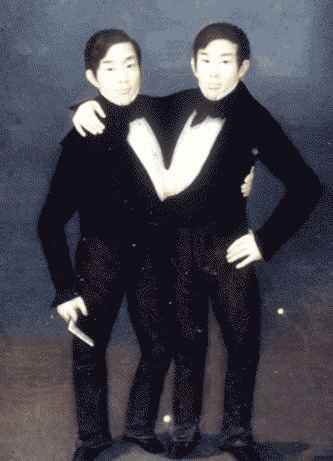Citizenship Siamese
American Children 11 (Chang)
10 (Eng) | Name Chang Eng | |
 | ||
Born May 11, 1811 ( 1811-05-11 ) Samutsongkram, Siam (now Thailand) Died January 17, 1874(1874-01-17) (aged 62)
Mount Airy, North Carolina, U.S. Resting place White Plains Baptist Church Cemetery Spouse(s) Adelaide Yates (m. 1843–74) (Chang)
Sarah Anne Yates (m. 1843–74) (Eng) | ||
Chang and eng bunker siamese twin brothers
Chang (pinyin: Chāng; rtgs: Chan) and Eng (pinyin: Ēn; rtgs: In) Bunker (May 11, 1811 – January 17, 1874) were Thai-American conjoined twin brothers whose condition and birthplace became the basis for the term "Siamese twins".
Contents
- Chang and eng bunker siamese twin brothers
- World famous conjoined twins chang and eng bunker
- Life
- Later years and death
- Legacy
- Descendants
- Other prominent conjoined twins
- References
World famous conjoined twins chang and eng bunker
Life
The Bunker brothers were born on May 11, 1811, in the province of Samutsongkram, near Bangkok, in the Kingdom of Siam (today's Thailand). Their fisherman father was a Chinese Thai, while their mother, Nok, (rtgs: Nak) was half-Chinese and half-Malay. Because of their Chinese heritage, they were known locally as the "Chinese Twins". The brothers were joined at the sternum by a small piece of cartilage, and though their livers were fused, they were independently complete.
In 1829, Robert Hunter, a Scottish merchant who lived in Bangkok, saw the twins swimming and realized their potential. He paid their parents to permit him to exhibit their sons as a curiosity on a world tour. When their contract with Hunter was over, Chang and Eng went into business for themselves. In 1839, while visiting Wilkesboro, North Carolina, the brothers were attracted to the area and purchased a 110-acre (0.45 km2) farm in nearby Traphill.
Determined to live as normal a life they could, Chang and Eng settled on their small plantation and bought slaves to do the work they could not do themselves. Using their adopted name "Bunker", they married local women on April 13, 1843. Chang wed Adelaide Yates (1823-1917), while Eng married her sister, Sarah Anne (1822-1892). The twins also became naturalized American citizens.
The couples shared a bed built for four in their Traphill home. Chang and Adelaide would become the parents of twelve children. Eng and Sarah had ten. However, Chichester disputes this number of children, stating Eng had 11. After a number of years, the sisters began to dislike each other and separate households were set up west of Mount Airy, North Carolina in the town of White Plains. The brothers would alternately spend three days at each home. During the American Civil War, Chang's son Christopher and Eng's son Stephen both served in the Confederate army. The twins lost most of their money with the defeat of the Confederacy and became very bitter. They returned to public exhibitions, but this time they had little success. Nevertheless, they maintained a high reputation for honesty and integrity, and they were highly respected by their neighbors.
Later years and death
In 1870, Chang suffered a stroke and his health declined over the next four years. He also began drinking heavily (Chang's drinking did not affect Eng as they did not share a circulatory system). Despite his brother's ailing condition, Eng remained in good health. Shortly before his death, Chang was injured after falling from a carriage. He then developed a severe case of bronchitis. On January 17, 1874, Chang died while the brothers were asleep. Eng awoke to find his brother dead and cried, "Then I am going". A doctor was summoned to perform an emergency separation, but he was too late. Eng died approximately three hours later.
An autopsy revealed that Chang had died of a cerebral blood clot but Eng's cause of death remains uncertain. Doctors of the time theorized that Eng died of shock due to fear of his impending death. They based that theory on the fact that Eng's bladder had distended with urine and his right testicle had retracted. Two North Carolina neurologists, Dr. Paul D. Morte and Dr. E. Wayne Massey, reviewed the case and concluded that Chang likely died of pulmonary edema and heart failure. They also dismissed the claim that Eng died of shock and attributed the muscle cramping that caused his testicle to retract to "acrocyanosis from induced vasospasm and microthrombi due to disseminated intravascular coagulation, the tissue factor released from necrotic tissue and the endotoxin from sepsis activating coagulation cascade".
Sarah Anne Bunker (Eng's widow) died on April 29, 1892, and Adelaide Bunker (Chang's widow) died on May 21, 1917.
Legacy
Descendants
Chang and Eng Bunker fathered a total of 21 children, and their descendants now number more than 1,500. Many of their descendants continue to reside in the vicinity of Mount Airy, and descendants of both brothers continue to hold joint reunions. Two hundred descendants reunited in Mount Airy in July 2011 for the twins' 200th birthday and for the descendants' 22nd annual reunion.
Prominent descendants include:
